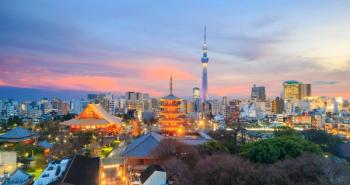
- January 2023
- Volume 19
- Issue 01
- Pages: 25–26
SCM-10 Event Preview
The Tenth International Symposium on the Separation and Characterization of Natural and Synthetic Macromolecules, SCM-10, will take place 1–3 February 2023 in Amsterdam, the Netherlands. The organizing committee reveal what attendees can look forward to.
The Tenth International Symposium on the Separation and Characterization of Natural and Synthetic Macromolecules, SCM-10, will take place 1–3 February 2023 in Amsterdam, the Netherlands. The organizing committee reveal what attendees can look forward to.
There is a great deal of interest in the subject of large-molecule characterization, be it synthetic polymers—where we have learned that conventional characterization methods fall short in guiding innovation; recycled polymers—the safety and efficacy of which cannot yet be properly assessed; biopolymers, such as cellulose and lignin, that are still notoriously difficult to characterize; or proteins—the behaviour of which is affected by the smallest details in their structure. Scientists working on these various types of macromolecules rarely meet, because they are anchored in different fields. However, they share a number of common techniques, or at least technology with a common basis. On this communal ground scientists will meet for the tenth time at the SCM conference on the Separation and Characterization of Macromolecules in Amsterdam on 1–3 February 2023.
Common technology for all the above fields include liquid chromatography (LC) in many forms, but especially size‑exclusion chromatography (SEC), and mass spectrometry (MS). One-day short courses will be presented on these key subjects on the two days preceding the conference. Laurence Charles, from the Institute for Radical Chemistry at the Aix-Marseille University (Marseille, France), will discuss various aspects of polymer mass spectrometry on Monday 30 January. She will present the basics but also some of her own eye-catching results. On Tuesday 31 January, André Striegel, from the National Institute of Standards & Technology (NIST) in Gaithersburg (Maryland, USA), will discuss liquid chromatographic techniques for polymer separation and characterization. André is arguably the leading expert in this field. Both courses offer fantastic opportunities for students and professionals to refresh the basics and to catch up with developments in the field.
Other liquid-phase separation techniques will be discussed at the conference, including gradient LC, hydrophobic‑interaction chromatography (HIC), hydrodynamic chromatography (HDC), capillary electrophoresis (CE), and various two‑dimensional techniques, including comprehensive two-dimensional LC (LC×LC). There is a great deal of interest in field-flow fractionation (FFF) techniques, a field that has been steadily growing during the 20 years of existence of the SCM conference. FFF offers exciting possibilities for characterizing very large molecules and nanoparticles, as encountered, for example, in drug formulations.
Separation methods go hand in hand with characterization methods, although it can be argued that MS is a bit of both. SCM will feature presentations on combinations of MS with LC and SEC, pyrolysis-gas chromatography (Py-GC), ion-mobility spectrometry (IMS), and even FFF. However, MS is not always the answer. MS provides accurate masses, but molecules need to be brought into the gas (or near-vacuum) phase and the quest for measurements under “native” conditions has not come to a final conclusion—measurements in the liquid phase, using spectroscopic techniques, such as nuclear magnetic resonance (NMR) (is it really quantitative?), viscometry, and light‑scattering detectors. The latter are still as tightly interwoven with the SCM field as MS, and the application domains of MS and light scattering overlap only partially.
All these tools bring new insights in the many applications that come together at SCM, including materials and coatings, recycling, bio(-based)-materials, (bio-)pharmaceuticals, and drug formulations. An eye-catching application of the many technologies being discussed is the characterization of objects of cultural heritage, which will be discussed in at least a handful of presentations, ranging from protein binders to Asian lacquers.
People involved in the separation and characterization of natural and synthetic macromolecules share a great deal of common interest and they have a lot to discuss. The SCM community has not been together for four years—for obvious reasons—and the opportunity to have a live meeting again is exciting. The community has responded with a record number of submitted presentations, resulting in what is possibly the strongest ever SCM scientific programme. The SCM conference also offers a unique atmosphere that encourages interactions between all scientists, students, exhibitors, and other delegates. It is the perfect place to meet and to get to know colleagues, to renew friendships, and to make new friends. For science and for life.
Peter Schoenmakers has been affiliated with the University of Amsterdam as a professor of analytical chemistry for nearly 25 years. His research has had a strong focus on the separation (and characterization) of macromolecules and on multidimensional and hyphenated techniques. He is the scientific chairman of the SCM-10 conference.
Articles in this issue
almost 3 years ago
Playing with Selectivity for Optimal Chiral Separationalmost 3 years ago
Rising Stars of Separation Science: Martina Catanialmost 3 years ago
Agilent Achieves “Angel” Level Sponsorship of My Green Labalmost 3 years ago
Thermo Opens New Site in Chinaalmost 3 years ago
A Focus on Forensic Taphonomy and Chromatographyalmost 3 years ago
Vol 19 No 1 The Column January 2023 North American PDFalmost 3 years ago
Vol 19 No 1 The Column January 2023 Europe & Asia PDFNewsletter
Join the global community of analytical scientists who trust LCGC for insights on the latest techniques, trends, and expert solutions in chromatography.




